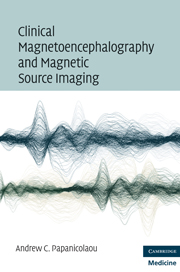Book contents
- Frontmatter
- Contents
- Contributors
- Preface
- Section 1 The method
- 1 Basic concepts
- 2 The nature and origin of magnetic signals
- 3 Recording the magnetic flux
- 4 Overview of MSI using the single equivalent current dipole (ECD) model as an example
- 5 The fundamental problems of MSI
- 6 Head models
- 7 Source models – discrete source models
- 8 Source models – distributed source models
- 9 Source models – beamformers
- 10 Pragmatic features of the clinical use of MEG/MSI
- Section 2 Spontaneous brain activity
- Section 3 Evoked magnetic fields
- Postscript: Future applications of clinical MEG
- References
- Index
1 - Basic concepts
from Section 1 - The method
Published online by Cambridge University Press: 01 March 2010
- Frontmatter
- Contents
- Contributors
- Preface
- Section 1 The method
- 1 Basic concepts
- 2 The nature and origin of magnetic signals
- 3 Recording the magnetic flux
- 4 Overview of MSI using the single equivalent current dipole (ECD) model as an example
- 5 The fundamental problems of MSI
- 6 Head models
- 7 Source models – discrete source models
- 8 Source models – distributed source models
- 9 Source models – beamformers
- 10 Pragmatic features of the clinical use of MEG/MSI
- Section 2 Spontaneous brain activity
- Section 3 Evoked magnetic fields
- Postscript: Future applications of clinical MEG
- References
- Index
Summary
Magnetoencephalography (MEG) is the noninvasive method of recording from the head surface the magnetic flux associated with intracranial electrical currents. An MEG recording resembles the familiar electroencephalogram (EEG) and is used in two ways. The first use, similar to that of conventional EEG and evoked potentials (EPs), is for detecting the presence of signs of abnormality in spontaneous brain “activity” (e.g., epileptiform spike-and-wave patterns) or in evoked-response activity (e.g., delayed or low-amplitude somatosensory activity averaged in response to multiple median-nerve stimulations). The second use of MEG recording is for estimating the locations and time courses of sources of either spontaneous or evoked events of interest, a process called magnetic source imaging (MSI). This second use renders MEG a unique supplement to – and, in some cases, a substitute for – EEG and EPs. Although MEG denotes processes involving the recording of signals and their evaluation as they appear on the head surface (sensor space) and MSI refers to processes involving the localization of the sources of those signals and the construction of “maps” or “images” of brain activity and activation, in practice – and even in formal discourse – these two terms (MEG and MSI) are often used interchangeably.
The source of the activities recorded by MEG originates from an electrochemical process called neural signaling. Of the three main processes that occur in the brain, neural signaling is the most basic and direct. The other two processes, metabolism and blood flow, have rates that depend on neuronal activity and thus are imaged indirectly through methods such as positron-emission tomography (PET) and functional magnetic resonance imaging (fMRI).
- Type
- Chapter
- Information
- Publisher: Cambridge University PressPrint publication year: 2009
- 1
- Cited by



